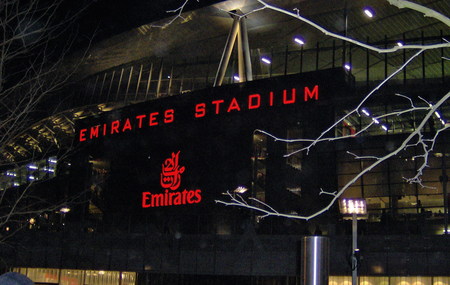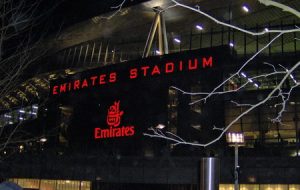Many Americans may think they own a monopoly on sports fanaticism, but viewing a soccer match in Great Britain would quickly dispel this notion. From national-team games played at London’s behemoth Wembley Stadium to such English Premier League titans as Arsenal and Manchester United to small-town, lower-division teams, stadia throughout the country fill routinely with vociferous, logo-clad fans of the “beautiful game.”
HOK Sport’s London office built and developed environmental graphics for London’s Emirates Stadium, home of Arsenal, which was founded in 1886 by workers at the Woolwich Arsenal armament factory and gradually evolved into one of the perennial top contenders in the English Premier League.
Simon Borg designed the stadium’s environmental graphics. His resumé includes developing environments for a museum in Victoria, Australia, as well as a stint with London-based architect BDG McColl before joining HOK.
When developing stadium graphics, he said his primary duty entails developing a thorough, cohesive system: “There’s so much information that has to be conveyed on so many levels, from the parking lot to the ticket booth to the concourse, to getting people to their seats. Every sign must flow and mesh naturally with the architecture.”
Accommodating the burgeoning trend of stadium-naming rights, which has been ubiquitous in the United States for more than a decade but a newer trend in Europe, requires even more detail. Borg said, “For some companies that buy naming rights, the composition of the signage is very important; to others, it’s only important to place the logo in as many different places as possible. In this case, we knew the stadium would have a corporate sponsor, but that decision wasn’t made until one year before project completion. The original wayfinding hadn’t accounted for a corporate sponsor, so this required rework and somewhat tight, but manageable, deadlines.”
Advertisement
Emirates Airlines, the United Arab Emirates’ airline, claimed naming rights for the Arsenal stadium. Although they certainly wanted environmental graphics that clearly articulated their corporate presence, he said Emirates officials also respected Arsenal’s tradition.
Borg transported certain elements of Highbury, the team’s prior stadium for 80 years, into the new facility. For instance, prominent entry signage comprised a replication of Highbury’s original Bank Gothic typeface.
Wood & Wood (Exeter, England) and Rivermeade (London) fabricated diverse elements of Emirates’ signage. According to Veronica Devereux, Wood & Wood’s marketing manager, the 40-year-old shop fabricated 16 primary-ID signs, which involved three types: the “Emirates Stadium” point-of-entry IDs, the Emirates logo and the well-known Arsenal shield.
Wood and Wood’s designers began by transforming the logos into 3-D renderings using Autodesk’s (San Rafael, CA) 3-D Studio Max, which enabled better conceptual understanding and the opportunity to address any technical flaws before fabrication began.
Wood & Wood constructed the point-of-entry sign fixtures, which comprise 4½-ft.-tall channel letters, from descaled stainless steel, which they covered with a polyester powdercoating to ensure color matches. To illuminate the letters, Wood & Wood used GE Lumination’s high-intensity, white LEDs, which it diffused with a layer of red acrylic sheet. Borg said the recent descent in white LED prices and long-term energy savings influenced the lighting choice.
The four Arsenal shields posed the most significant challenges. HOK had initially designed them to measure approximately 16½ x 20 ft., with internal lighting and no visible hardware. But, as the project progressed, their specs grew to 26½ x 21½ ft., with custom, remote spotlights that enliven the shields’ color.
Advertisement
To accomplish this, Wood & Wood chose to fabricate them from polycarbonate and created a central interior joint that enabled two-piece shield construction while accentuating the shield’s nuanced red shades.
The shields’ support structures comprise 2mm-thick, descaled stainless steel and 3mm aluminum. Wood & Wood fashioned HOK’s specified stainless-steel cladding system, which required engineering to very tight tolerances to fit the existing fixtures. Installation required two, 40-ton Liftlux SL320 scissor lifts working in tandem with an 80-ton crane and eight fitting engineers.
Rivermeade, an 80-employee, 30-year-old shop, fabricated approximately 2,000 directional and location graphics that shepherd Arsenal fans from the parking lot to seating, as well as wall-mounted signage that identifies public areas throughout the stadium. Lindsay Wilcox, Rivermeade’s sales and marketing director, said the fabrication team developed custom, aluminum extrusions that “would eliminate the often inevitable ‘hand-built’ appearance of built, welded metal common to projects of this scale.”
Wilcox also noted that for large projects, where frequent change orders and seemingly infinite cost variables can lead to headache-inducing cost overruns, value engineering, through streamlined hardware, construction and material choices, translates into successful projects – and, the ultimate goal, referrals or repeat business.
Rivermeade constructed the aluminum sign faces using its battery of multi-axes Gerber Sabre 408 CNC routers and thermal-arc MIG welders.



 Tip Sheet4 days ago
Tip Sheet4 days ago
 Business Management2 weeks ago
Business Management2 weeks ago
 Women in Signs2 weeks ago
Women in Signs2 weeks ago
 Real Deal5 days ago
Real Deal5 days ago
 Benchmarks23 hours ago
Benchmarks23 hours ago
 Editor's Note1 week ago
Editor's Note1 week ago
 Line Time2 weeks ago
Line Time2 weeks ago
 Product Buying + Technology1 week ago
Product Buying + Technology1 week ago










